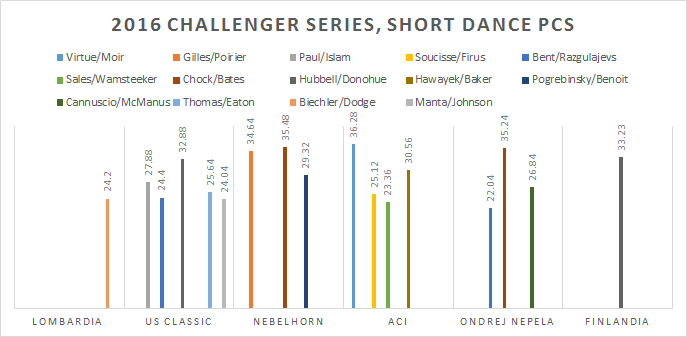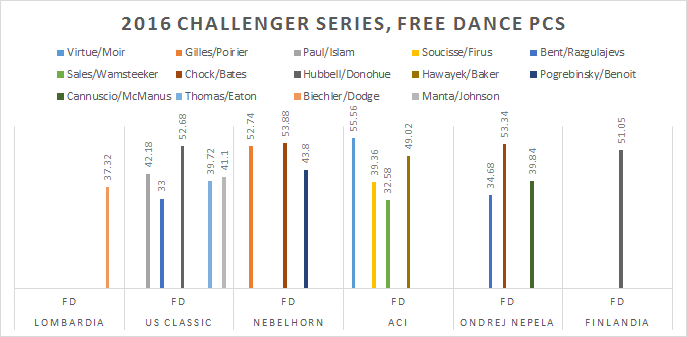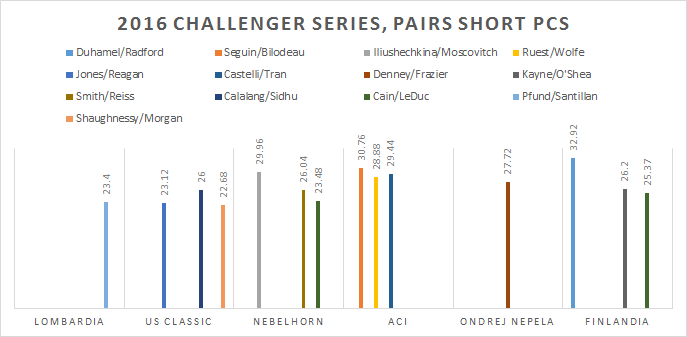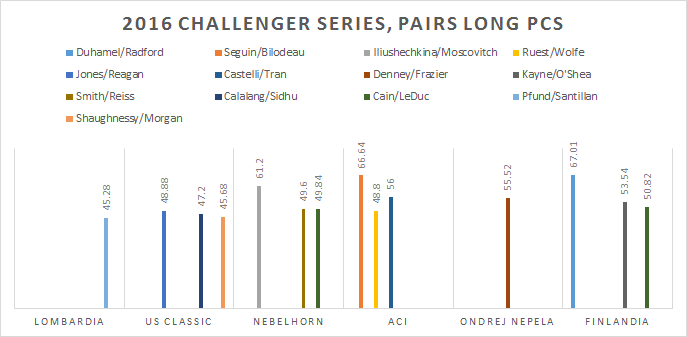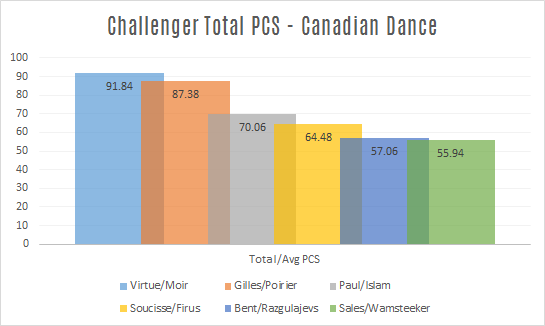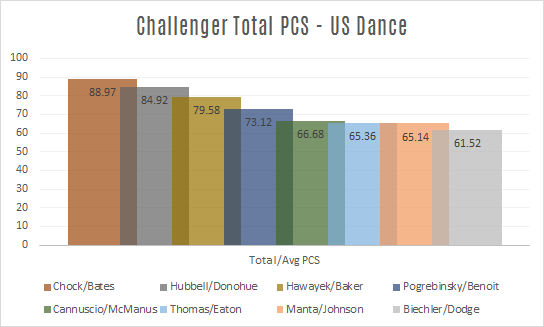With Finlandia Trophy, the pre-Grand Prix — and most pivotal — stretch of the ISU’s 2016 Challenger Series has concluded, along with the debuts of most of the US and Canada’s international dance teams and pairs. Notable absences like Maia and Alex Shibutani (USA) and Kaitlyn Weaver and Andrew Poje (CAN) in dance, and Alexa Scimeca Knierim and Chris Knierim (USA) and Kirsten Moore-Towers and Michael Marinaro (CAN) in pairs, make any more predictive analysis difficult if not ill-advised, but a quick look at how (non-anonymous!) judges across varied events are scoring couples is still worth our time.
With a few teams tackling multiple events — and seeing just an average 0.91-point variation in marks between those events — it’s also reasonable to gather that, separate panels notwithstanding, there’s an established, understood range in place for many duos.
Lombardia Trophy: Julia Biechler / Damian Dodge (USA) | US International Figure Skating Classic: Madison Hubbell / Zach Donohue, Karina Manta / Joe Johnson, Danielle Thomas / Daniel Eaton (USA), Alexandra Paul / Mitch Islam, Mackenzie Bent / Dmitre Razgulajevs (CAN) | Nebelhorn Trophy: Madison Chock / Evan Bates, Elliana Pogrebinsky / Alex Benoit (USA), Piper Gilles / Paul Poirier (CAN) | Autumn Classic International: Tessa Virtue / Scott Moir, Carolane Soucisse / Shane Firus, Haley Sales / Nikolas Wamsteeker (CAN), Kaitlin Hawayek / Jean-Luc Baker (USA) | Ondrej Nepela Memorial: Chock / Bates, Anastasia Cannuscio / Colin McManus (USA), Bent / Razgulajevs (CAN) | Finlandia Trophy: Hubbell / Donohue (USA)
Lombardia Trophy: Jessica Pfund / Josh Santillan (USA) | US International Figure Skating Classic: Brittany Jones / Josh Reagan (CAN), Jessica Calalang / Zack Sidhu, Alexandria Shaughnessy / Jimmy Morgan (USA) | Nebelhorn Trophy: Lubov Iliushechkina / Dylan Moscovitch (CAN), Erika Smith / AJ Reiss, Ashley Cain, Timothy LeDuc (USA) | Autumn Classic International: Julianne Séguin / Charlie Bilodeau, Camille Ruest / Drew Wolfe (CAN), Marissa Castelli / Mervin Tran (USA) | Ondrej Nepela Memorial: Haven Denney / Brandon Frazier (USA) | Finlandia Trophy: Meagan Duhamel / Eric Radford (CAN), Tarah Kayne / Danny O’Shea, Cain / LeDuc (USA)
As ever, dance might raise a few more questions than pairs, where marks are roughly in line with expectations — even if, for example, even a promising new team like Ruest/Wolfe would likely see greater separation in a clean skate’s marks from those of Iliushechkina/Moscovitch when competing at an event scored on a more subdued scale than Autumn Classic was.
But helpful as it is to consider per-segment scores, a look at total differentials (with averages provided for those teams who competed at two events) is a bit more illuminating:
What can we take from these graphs? First, it’s clear that the race within the U.S. field is far tighter, even as most teams are unlikely to contend for 2017’s national podium. The average PCS distance between any two successive teams is only 3.92 points.
Second — assuming, based on history, a score for Weaver/Poje in line with those of Chock/Bates and Gilles/Poirier — Canadian dance is focused on its presumed top three. The 17.32-point PCS gap between Gilles/Poirier and Paul/Islam is the greatest between any two successive teams in either country, and it’s also an all-time large international gap between the couples; in last season’s Challenger Series (where Gilles/Poirier won Ondrej Nepela and Paul/Islam took silver at Nebelhorn), the gap was only 3.68, and on the Grand Prix, 5.7.
Finally, while Hubbell/Donohue hope to close their own gap with the top US couples (assuming, again, for the Shibutanis a high mark), they do sit closer to Chock/Bates than Hawayek/Baker do to them — good news for hopes of at least retaining a top three spot, and further good news for Hawayek/Baker, who are several PCS points safe so far for at least retaining a top four spot.
It’s simple enough to speculate that some outlying marks may be a simple case of national support. For example, in the Autumn Classic short dance ESP’s Marta Olozagarre gave panel-high marks to ESP’s Olivia Smart and Adriá Diaz (including their only 8) and Celia Robledo and Luis Fenero (including their only 7) — but this trend was shaken in the free dance, when Australia’s Angelique Clyde-Smith provided Smart/Diaz with an even higher set of all 8+s and came in only 0.25 shorter on marks for Robledo/Fenero, while Olozagarre was not the high marker for Smart/Diaz at their first Challenger event.
So it’s a bit more interesting to set aside nation-specific concerns and simply see how judges who’ve tackled more than one Challenger this season have marked the teams of our interest, tallying up each of these judge’s individual component marks per team, per segment:

